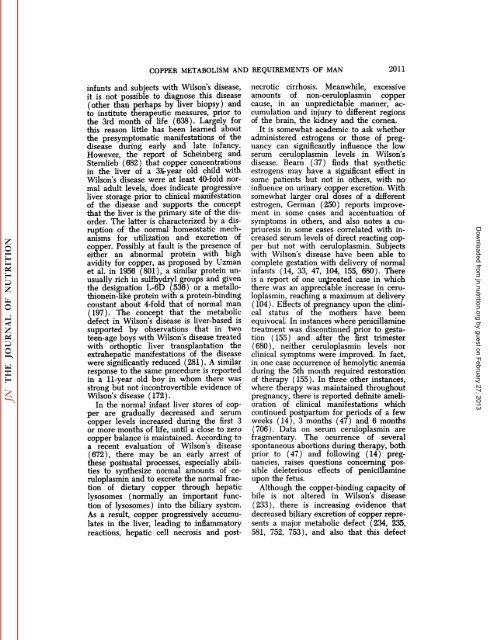conspectus of researchon copper metabolism and requirements
conspectus of researchon copper metabolism and requirements
conspectus of researchon copper metabolism and requirements
You also want an ePaper? Increase the reach of your titles
YUMPU automatically turns print PDFs into web optimized ePapers that Google loves.
COPPER METABOLISM AND REQUIREMENTS OF MAN 2011<br />
infants <strong>and</strong> subjects with Wilson's disease,<br />
it is not possible to diagnose this disease<br />
(other than perhaps by liver biopsy) <strong>and</strong><br />
to institute therapeutic measures, prior to<br />
the 3rd month <strong>of</strong> life (638). Largely for<br />
this reason little has been learned about<br />
the presymptomatic manifestations <strong>of</strong> the<br />
disease during early <strong>and</strong> late infancy.<br />
However, the report <strong>of</strong> Scheinberg <strong>and</strong><br />
Sternlieb (682) that <strong>copper</strong> concentrations<br />
in the liver <strong>of</strong> a 3M-year old child with<br />
Wilson's disease were at least 40-fold nor<br />
mal adult levels, does indicate progressive<br />
liver storage prior to clinical manifestation<br />
<strong>of</strong> the disease <strong>and</strong> supports the concept<br />
that the liver is the primary site <strong>of</strong> the dis<br />
order. The latter is characterized by a dis<br />
ruption <strong>of</strong> the normal homeostatic mech<br />
anisms for utilization <strong>and</strong> excretion <strong>of</strong><br />
<strong>copper</strong>. Possibly at fault is the presence <strong>of</strong><br />
either an abnormal protein with high<br />
avidity for <strong>copper</strong>, as proposed by Uzman<br />
et al. in 1956 (801), a similar protein un<br />
usually rich in sulfhydryl groups <strong>and</strong> given<br />
the designation L-6D (536) or a metallothionein-like<br />
protein with a protein-binding<br />
constant about 4-fold that <strong>of</strong> normal man<br />
(197). The concept that the metabolic<br />
defect in Wilson's disease is liver-based is<br />
supported by observations that in two<br />
teen-age boys with Wilson's disease treated<br />
with orthoptic liver transplantation the<br />
extrahepatic manifestations <strong>of</strong> the disease<br />
were significantly reduced (281 ). A similar<br />
response to the same procedure is reported<br />
in a 11-year old boy in whom there was<br />
strong but not incontrovertible evidence <strong>of</strong><br />
Wilson's disease (172).<br />
In the normal infant liver stores <strong>of</strong> cop<br />
per are gradually decreased <strong>and</strong> serum<br />
<strong>copper</strong> levels increased during the first 3<br />
or more months <strong>of</strong> life, until a close to zero<br />
<strong>copper</strong> balance is maintained. According to<br />
a recent evaluation <strong>of</strong> Wilson's disease<br />
(672), there may be an early arrest <strong>of</strong><br />
these postnatal processes, especially abili<br />
ties to synthesize normal amounts <strong>of</strong> ceruloplasmin<br />
<strong>and</strong> to excrete the normal frac<br />
tion <strong>of</strong> dietary <strong>copper</strong> through hepatic<br />
lysosomes (normally an important func<br />
tion <strong>of</strong> lysosomes) into the biliary system.<br />
As a result, <strong>copper</strong> progressively accumu<br />
lates in the liver, leading to inflammatory<br />
reactions, hepatic cell necrosis <strong>and</strong> post-<br />
necrotic cirrhosis. Meanwhile, excessive<br />
amounts <strong>of</strong> non-ceruloplasmin <strong>copper</strong><br />
cause, in an unpredictable manner, ac<br />
cumulation <strong>and</strong> injury to different regions<br />
<strong>of</strong> the brain, the kidney <strong>and</strong> the cornea.<br />
It is somewhat academic to ask whether<br />
administered estrogens or those <strong>of</strong> preg<br />
nancy can significantly influence the low<br />
serum ceruloplasmin levels in Wilson's<br />
disease. Beam (37) finds that synthetic<br />
estrogens may have a significant effect in<br />
some patients but not in others, with no<br />
influence on urinary <strong>copper</strong> excretion. With<br />
somewhat larger oral doses <strong>of</strong> a different<br />
estrogen, German (250) reports improve<br />
ment in some cases <strong>and</strong> accentuation <strong>of</strong><br />
symptoms in others, <strong>and</strong> also notes a cupriuresis<br />
in some cases correlated with in<br />
creased serum levels <strong>of</strong> direct reacting cop<br />
per but not with ceruloplasmin. Subjects<br />
with Wilson's disease have been able to<br />
complete gestation with delivery <strong>of</strong> normal<br />
infants (14, 33, 47, 104, 155, 680). There<br />
is a report <strong>of</strong> one untreated case in which<br />
there was an appreciable increase in ceru<br />
loplasmin, reaching a maximum at delivery<br />
( 104). Effects <strong>of</strong> pregnancy upon the clini<br />
cal status <strong>of</strong> the mothers have been<br />
equivocal. In instances where penicillamine<br />
treatment was discontinued prior to gesta<br />
tion (155) <strong>and</strong> after the first trimester<br />
(680), neither ceruloplasmin levels nor<br />
clinical symptoms were improved. In fact,<br />
in one case occurrence <strong>of</strong> hemolytic anemia<br />
during the 5th month required restoration<br />
<strong>of</strong> therapy (155). In three other instances,<br />
where therapy was maintained throughout<br />
pregnancy, Aere is reported definite ameli<br />
oration <strong>of</strong> clinical manifestations which<br />
continued postpartum for periods <strong>of</strong> a few<br />
weeks (14), 3 months (47) <strong>and</strong> 6 months<br />
(706). Data on serum ceruloplasmin are<br />
fragmentary. The ocurrence <strong>of</strong> several<br />
spontaneous abortions during therapy, both<br />
prior to (47) <strong>and</strong> following (14) preg<br />
nancies, raises questions concerning pos<br />
sible deleterious effects <strong>of</strong> penicillamine<br />
upon the fetus.<br />
Although the <strong>copper</strong>-binding capacity <strong>of</strong><br />
bile is not altered in Wilson's disease<br />
(233), there is increasing evidence that<br />
decreased biliary excretion <strong>of</strong> <strong>copper</strong> repre<br />
sents a major metabolic defect (234, 235,<br />
581, 752, 753), <strong>and</strong> also that this defect<br />
Downloaded from<br />
jn.nutrition.org<br />
by guest on February 27, 2013
















